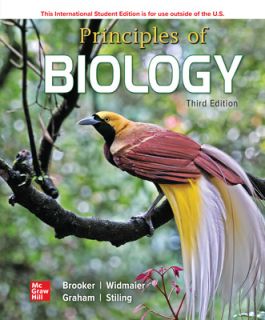Ise Ebook For Principles Of Biogy, 3E (180 Days)
To access your eBook, sign in or register at McGraw Hill Bookshelf and you will be instructed to enter your access code.
After adding your eBook to the McGraw Hill Bookshelf, download the ReadAnywhere app on the App Store or Google Play. Sign into your McGraw Hill Bookshelf or Connect account to access your eBook on the go and download chapters for offline reading.
For McGraw Hill eBook & ReadAnywhere support, click here.
1 An Introduction to Biology
Unit 1 Chemistry
2 The Chemical Basis of Life I: Atoms, Molecules, and Water
3 The Chemical Basis of Life II: Organic Molecules
Unit 2 Cell
4 The Evolutionary Origin of Cells and Their General Features
5 Membranes: The Interface between Cells and Their Environment
6 How Cells Utilize Energy
7 How Cells Capture Energy via Photosynthesis
8 How Cells Communicate with Each Other and with the Environment
Unit 3 Genetics
9 The Information of Life: DNA and RNA Structure, DNA Replication, and Chromosome Structure
10 The Expression of Genetic Information via Genes I:Transcription and Translation
11 The Expression of Genetic Information via Genes II: Non-coding RNAs
12 The Control of Genetic information via Gene Regulation
13 Altering the Genetic Material: Mutation, DNA Repair, and Cancer
14 How Eukaryotic Cells Sort and Transmit their Chromosomes:Mitosis and Meiosis
15 Transmission of Genetic Information from Parents to Offspring I: Patterns that Follow Mendel's Laws
16 Transmission of Genetic Information from Parents to Offspring II: Epigenetics, Linkage, and Extranuclear Inheritance
17 The Simpler Genetic Systems of Viruses and Bacteria
18 Genetic Technologies: How Biologists Study Genes and Genomes
Unit 4 Evolution
19 Evolution of Life I: How Populations Change from Generation to Generation
20 Evolution of Life II: The Emergence of New Species
21 How Biologists Classify Species and Study Their Evolutionary Relationships
22 The History of Life on Earth and Human Evolution
Unit 5 Diversity
23 Diversity of Microbial Life: Bacteria, Archaea, Protists,and Fungi
24 Microbiomes: Microbial Systems On and Around Us
25 Plant Evolution: How Plant Diversification Changed Planet Earth
26 Invertebrates: the Vast Array of Animal Life without a Backbone
27 Vertebrates: Fishes, Reptiles and Mammals
Unit 6 Flowering Plants
28 An Introduction to Flowering Plant Form and Function
29 How Flowering Plants Sense and Interact with Their Environments
30 How Flowering Plants Obtain and Transport Water, Mineral Nutrients, and Organic Compounds
31 How Flowering Plants Reproduce and Develop
Unit 7 Animals
32 General Features of Animal Bodies, and Homeostasis as a Key Principle of Animal Biology
33 Neuroscience I: The Structure, Function, and Evolution of Nervous Systems
34 Neuroscience II: How Sensory Systems Allow Animals to Interact with the Environment
35 How Muscles and Skeletons are Adaptations for Movement,Support, and Protection
36 Circulatory and Respiratory Systems: Transporting Solute sand Exchanging Gases
37 Digestive Systems and Excretory Systems: Maintaining Nutrient, Water, and Energy balance and removing waste
38 How Endocrine Systems Influence the Activities of all Other Organ Systems
39 The Production of Offspring: Reproduction and Development
40 Immune Systems: How Animals Defend Against Pathogens and Other Dangers
41 Integrated Responses of Animal Organ Systems to a Challenge to Homeostasis
Unit 8 Ecology
42 Behavioral Ecology: the Stru
McGraw-Hill Connect is an award-winning digital teaching and learning solution that empowers students to achieve better outcomes and enables instructors to improve course management efficiency.
High-Quality Course Material
Our trusted solutions are designed to help students actively engage in course content and develop critical higher-level thinking skills while offering you the flexibility to tailor your course to the ways you teach and the ways your students learn.
Assignments & Automatic Grading
Connect features a question bank that you can select from to create homework, practice tests and quizzes. Dramatically reduce the amount of time you spend reviewing homework and grading quizzes, freeing up your valuable time to spend on teaching.
Analytics & Reporting
Monitor progress and improve focus with Connect’s visual and actionable dashboards. Reports are available to empower both instructors and students with real-time performance analytics.
Seamless Integration
Link your Learning Management with Connect for single sign-on and gradebook synchronization, with all-in-one ease for you and your students.


